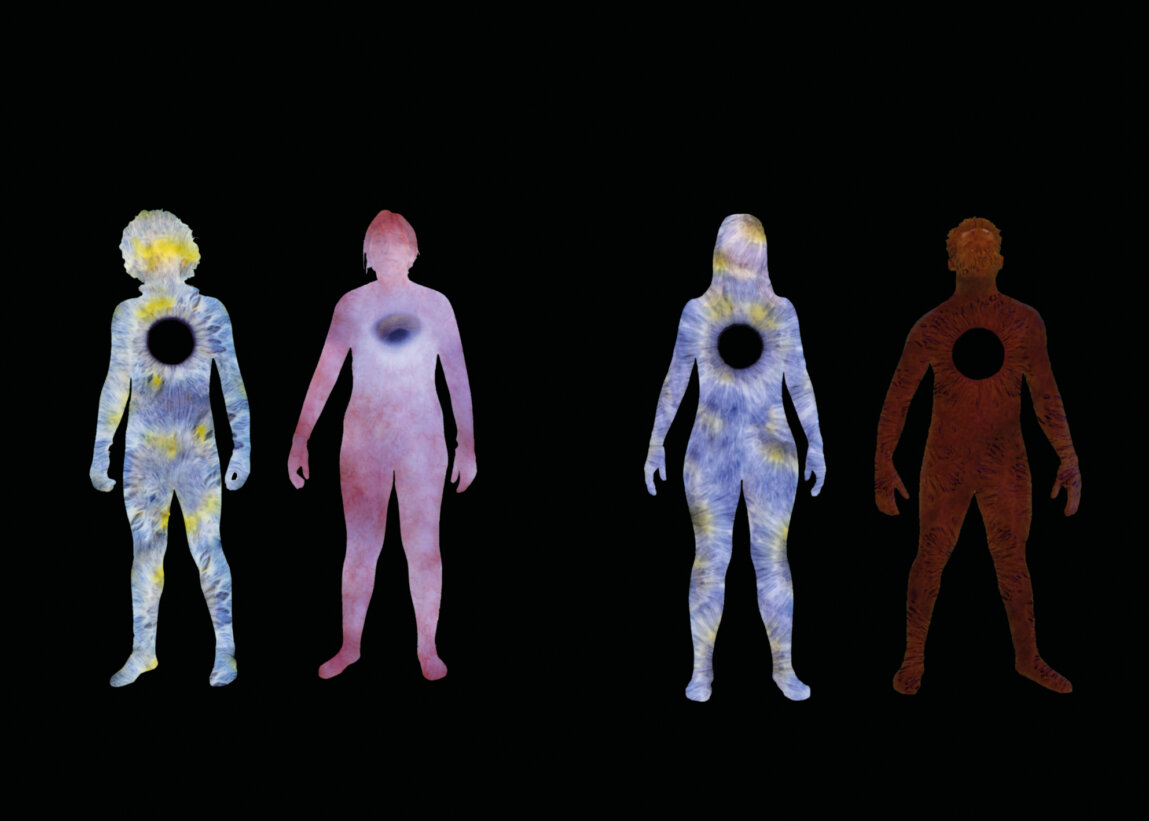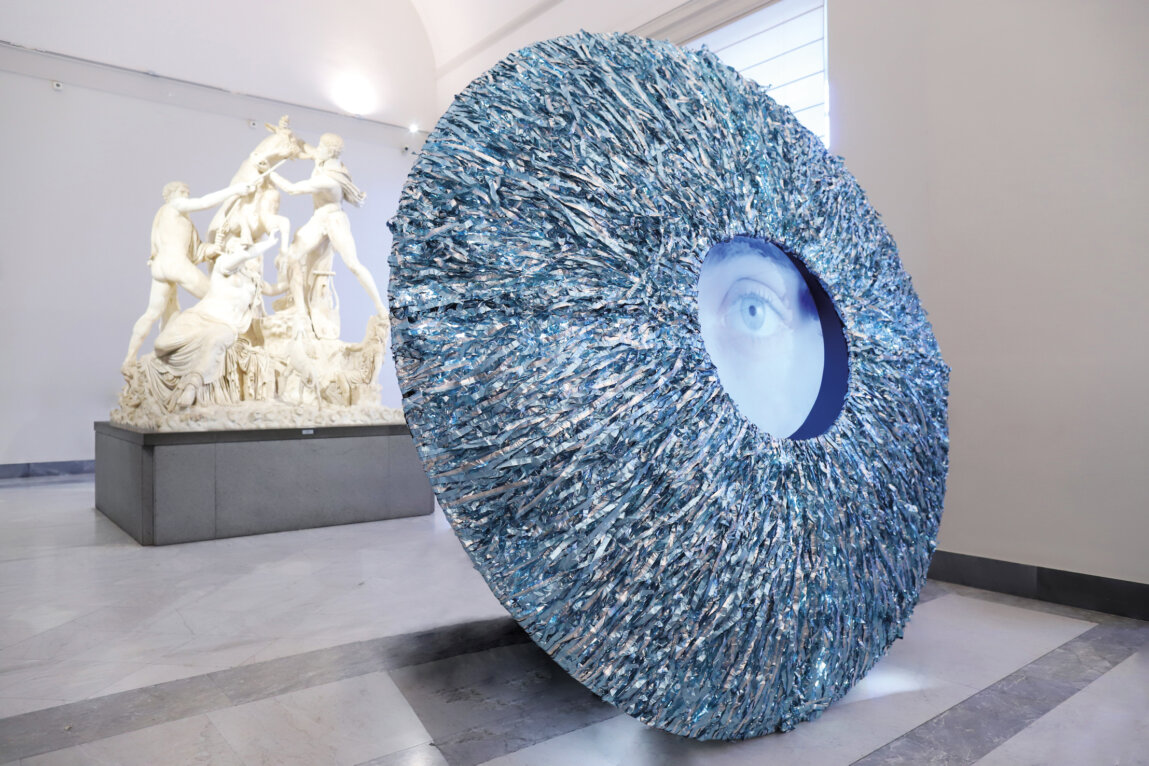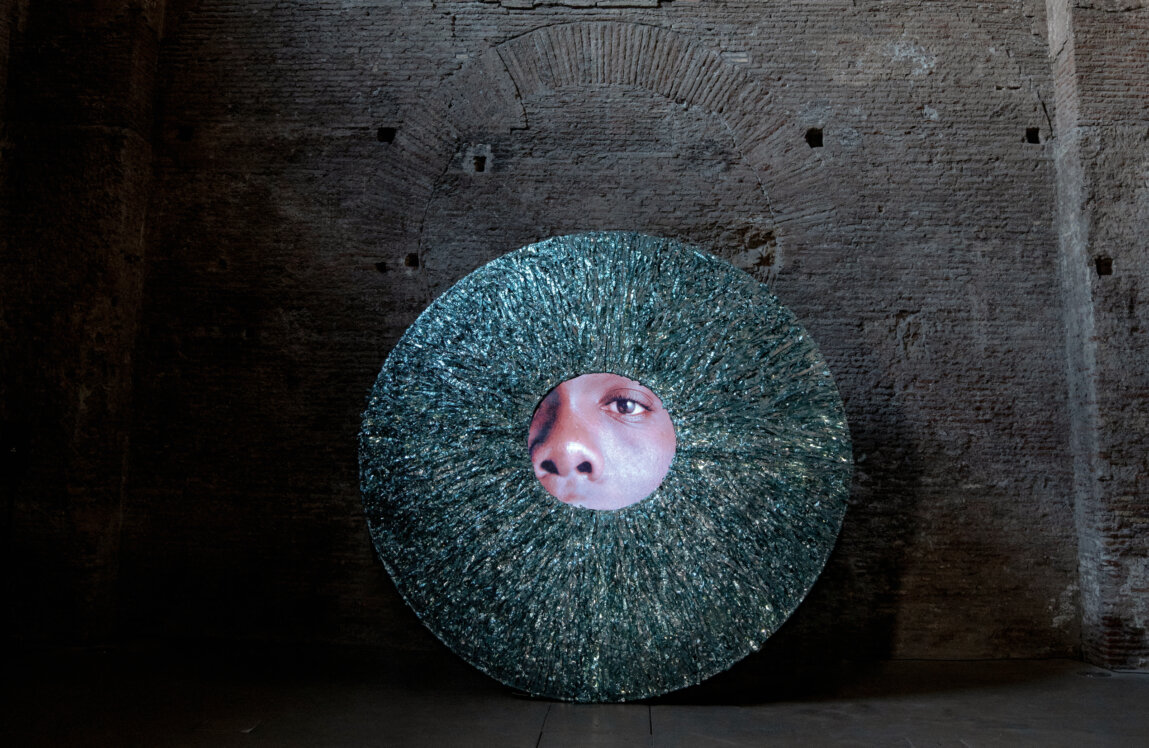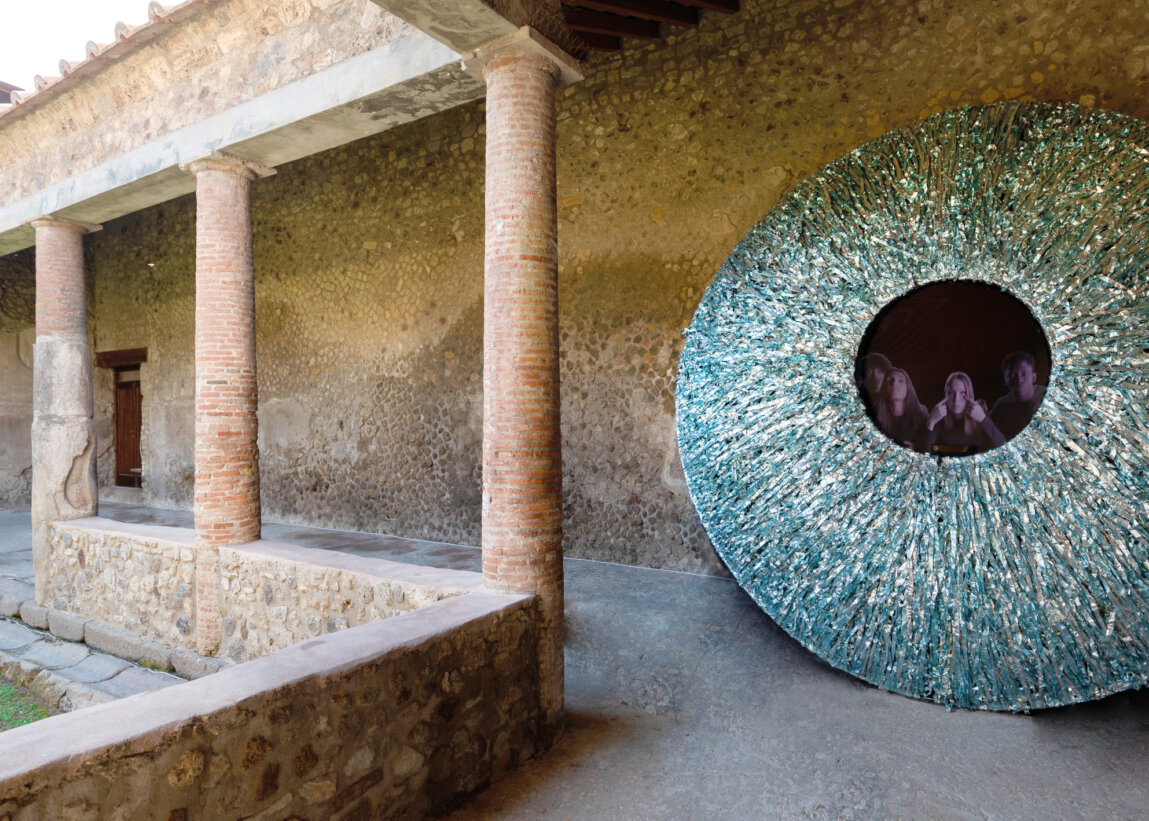
COLLÒCULI
2022
interactive multimedia installation
iron structure, recycled aluminum, monitor, video, sound, gesture-recognition camera
2022
interactive multimedia installation
iron structure, recycled aluminum, monitor, video, sound, gesture-recognition camera
[...] There is no symbol without inspiration, visible sphere without invisible, figuration without trans-figuration, sight without oversight, concentration without dispersion. The concept of transfiguration, of plastic “arterity”of the visible datum, reinterpreted, resemantized, a theme marginalized by so many contemporary gazes, seems to be at the center of Annalaura di Luggo’s artistic investigation. It is an “installation,” set up and contemplated in the project of Collòculi, in an unprecedented alternation between “iconography of the sensitive eye” and “synaesthesia of interaction,” shaping the total language of the multisensory work. Collòculi is a log that tends to the visible, that tries to bring to manifestation what is perceived, what the individual perceives, managing to give it a universal character. Annalaura di Luggo produces feelings of herself, of “life boys,” but, at the same time, she manages to speak of the history of the eye. Annalaura di Luggo “makes feelings” in a different way than we experience them, meaning that she produces them in a new way, not just re-produces, but produces something in which everyone can recognize themselves: “views” in which everyone can inhabit. Sight cannot live without art, for the simple reason that art cultivates the feeling of the eye--part to which it is attached--in the lives of others, in the colours of others, in the “life experiences of common sense.”COLLŎQUĬUM [COLLOQUIUM], COLLOQUIICONVERSATION, DIALOGUE, MEETINGŎCŬLUS [OCULUS], OCULIEYE, ORGAN OF VISIONCollòculi derives from the fusion of two lemmas, and in combining grammatical and artistic meaning, it becomes a circular form, taking as its “essential geometry” and as its “conceptual structure of sustainability” the link between person, work and environment. Sculptural project, media image and “multisensory” remediation, Annalaura di Luggo’s Collòculi, while modifying the context in which it is inserted, enables the activation of a mechanism of renewed awareness towards the installation, no longer or not only a surrogate of monumentality, but an opportunity to reread human dimensions transfigured in changing contexts. Form does not resolve in itself: it is effective and corporeal force and requires physical involvement to be “seen”, fruited and experienced. Plasticity, determined by the accumulation of recycled aluminum filaments, is the nest of interna movement (renewable and interchangeable) offered by a screen which, through a camera system (gesture recognition), makes the user an integral part of the action. [...]Gabriele Perretta

COLLÒCULI
Naples. MANN - Museo Archeologico Nazionale Napoli
[...] The digital faces of Pino, Noemi, Youssouf and Larissa, whose enigmatic eyes follow the camera movements, even involuntary, of the fascinated spectators, strike us. Are they duplicates, or other usselves asking us to participate in the Collòculi? Are we not by any chance sinking into a world of other Eyes? It is not a vain fear. The Collòculi techniques bring our eyes closer to their model of representation. Other symptoms are added, such as the media art’s taste for the post-ready-made, which transforms ordinary stories of four difficult boys and turns a life into a living sculpture. Even the role-playing exchanges between the theatre and the four boys lives, or the cult for their existential experimentation, where every dialogue, every iris, can suddenly take on a symbolic value which transforms it into the image of what comes close to salvation. [...] Collòculi > We Are Art is perhaps more than a representation: is it already an act or an act in potency? This relationship between image and life with its object intrigues and awakens the old controversy of catharsis, the power of a story to replace the real image of a spectator, to produce considerations, provocations, questions, emotions, substitutions. This is how the theophany is fulfilled in the symbols of transfigured and interactive sight: stories that are paths of affirmation of the individual and that nourish the meaning of a research; artistic and human interaction, oriented towards inclusive and comprehensive horizons. The starting point is about the eyes of four boys, victims of bullying, discrimination, alcohol and crime, who through the languages of video art and immersive reality, open wide a human and poetic universe, involving the viewer in a confrontation that cannot be without consequences, because “looking into each other’s eyes” means predisposing to dialogue, to encounter. Thus, in the soliciting and free practice of dialogue, the value of each individual in society is affirmed, stimulating our point of observation of the world. Resuming the observations conducted by Annalaura di Luggo, we are now called to see this transmutation-from sight and lives of others, to self-sight and life-through the singular process of Collòculi. [...]Gabriele Perretta

COLLÒCULI
Rome. Museo Nazionale Romano - Terme di Diocleziano
[...] Annalaura di Luggo, who considers blindness exemplary of all conditions of physical and psychological hardship, has continued to use the eye in works that also tackle themes of disability, psychological violence, addiction and discrimination. This intention is epitomized in the work Colloculi, a multimedia installation from 2022 that features an iris measuring 4 meters in diameter, comprised of recycled aluminum filaments and a screen. The work consists of three phases: the realization of the aluminum structure, the production of a video projected from a screen at the center of the sculpture and the active involvement of the public. Once the supporting structure of the sculpture was constructed, the artist collaborated with a group of about ten young people with different disabilities in order to assemble it. The video was recorded with the help of four young people acting as performers, who through their body language, without speaking, evoke their personal condition of hardship. At the beginning of the video, the young people tap on the screen to attract the attention of the public. One at a time, spectators are invited to occupy their own spot in front of the installation, where they find themselves sharing a virtual space with the four young people as they too are recorded on video. This initiates a process of identification with the conditions experienced by the protagonists of the video. [...] In the final bits of the film, the protagonists unzip their bodysuits, as if to liberate themselves of their old skin. Their silhouettes are then entirely covered by the projection of irises of different colors, indicating a new spiritual condition. In the final frame, their four silhouettes are united by a rope they each hold—a sort of connection created by this shared experience, but also a sign of the need to create relationships, to support one another, to put oneself in the shoes of another, to lift oneself out of a condition of isolation and to follow a path of rebirth. Unlike in Bruegel the Elder’s The Blind Leading the Blind, here sticking together prevents the risk of falling. This need is emphasized by the very title of the installation, which by uniting the word “colloquium” and “oculus,” denotes the idea of dialogue, a dialogue that can be made of words and gazes, or simply of small signs expressed through body language. Hence the artist’s desire to elevate the viewers of Colloculi to much more than mere observers. [...]Demetrio Paparoni

COLLÒCULI
Pompei. Parco Archeogico di Pompei - Terme del Foro
[...] With Collòculi, the imposing eye created in 2022 and displayed at the Banco di Napoli Foundation, the National Archeological Museum of Naples, the National Roman Museum and the Baths of Diocletian9—and today in the prestigious Archeological Park of Pompeii (Terme del Foro)—the title of the work arose from the association of two lemmas: collŏquĭum, (colloquium) and ŏcŭlus (eye). Social issues and dialogues intensify, they become clearer, opening a temporal breach between a primary moment (performative-laboratory-based) and a secondary moment (more strictly consumptive), in which the spectator, made complicit, is invited to activate the technological apparatus, to listen to a story (a hum, a heartbeat), a rich voice, to smell the nostalgic scent of humanity “The starting point are the eyes of four young people, victims of bullying, discrimination, alcohol and crime. [...] In its physical form, the work presents itself as an imposing eye whose iris is made of recycled aluminum (according to the sound principles of eco - sustainability) and whose large, enveloping and captivating pupil transmits interactive multimedia content in real time. Simultaneously, across a system of video cameras, gesture recognition sucks in the spectator, rendering him an integral and interactive part of We Are Art (a multimedia work in which the young people who worked with the artist solicit our attention by knocking on the delicate screen that unites and divides Innen und Aussen). Through various stratagems that recall certain procedures adopted by Studio Azzurro or Bill Viola, and fully entering the reality of pressing issues, Annalaura di Luggo creates a Deleuzian light regime—this is Collòculi, a regime of light (he who gives light risks darkeness, warned Montale)—in which the edge of time surrounding our present becomes a region in which the difference in discourses makes the other, and the external, shine, with the awareness of shaping lines of flight, lines of intersubjectivity and lines of force (at times even invisible and indescribable). These dissolve the dimension of power and usher in rhetorical trajectories to be learned, painful stories to be known (those of Noemi, Youssouf, Larissa and Pino) and elegiac existences that subtly transform private pain into collective and public matter. [...]Antonello Tolve
EXHIBITIONS
NAPLES
Fondazione Banco Napoli
march 14th - april 9th
may 1 - 31th, march 2022
NAPLES
MANN - Museo Archeologico Nazionale Napoli
october 12th 2022 - january 9th 2023
CHIETI
Palazzo De' Mayo
Fondazione Banco Napoli
february 24th - march 26th 2024
ROME
Museo Nazionale Romano
Terme di Diocleziano
june 12th - september 8th 2024
POMPEI
Parco Archeologico di Pompei
Terme del Foro
october 22th 2024 - may 4th 2025
CATALOGUES
COLLÒCULI > WE ARE ART
ANNALAURA DI LUGGO
edited by
Gabriele Perretta
introduction of
Paolo Giulierini
testimony by
Marcello Palminteri
Ludovico Solima
catalogue of the eponymous exhibition
NAPLES
MANN - Museo Archeologico Nazionale, Napoli
october 12th 2022 - january 9th 2023
2022
JUS Museum Edizioni, Naples
ISBN 9788894458725
COLLÒCULI | INTRO-SPECTIO
ANNALAURA DI LUGGO
edited by
Gabriele Perretta
introduction of
Stéphane Verger
texts
Stefano Lanna
Marcello Palminteri
Demetrio Paparoni
Gabriele Perretta
catalogue of the eponymous exhibition
ROME
Museo Nazionale Romano
Terme di Diocleziano
june 11th - september 9th 2024
2024
Silvana Editoriale, Milan
ISBN 9788836659272
ANNALAURA DI LUGGO
COLLOCULI@POMPEI
edited by
Antonello Tolve
introduction of
Gabriel Zuchtriegel
texts of
Antonello Tolve
Gabriele Perretta
catalogue of the eponymous exhibition
Mons. Tommaso Caputo
catalogue of the eponymous exhibition
POMPEI
Parco Archeologico di Pompei
Terme del Foro
october 22th 2024 - may 4th 2025
2024
Artem, Naples
ISBN 9788856910162


